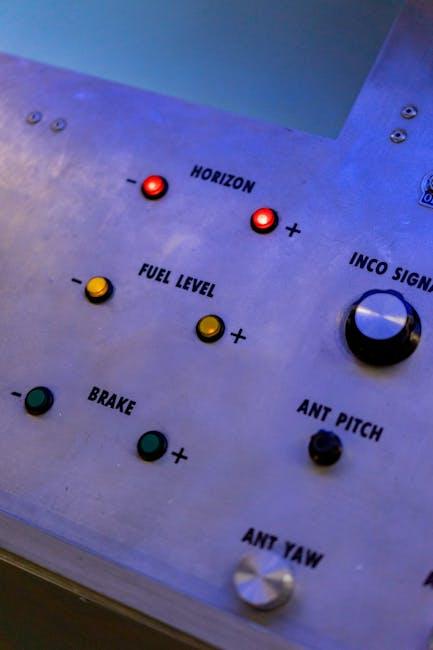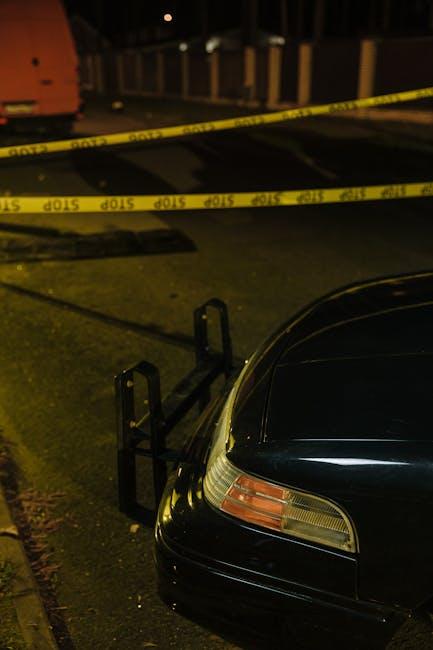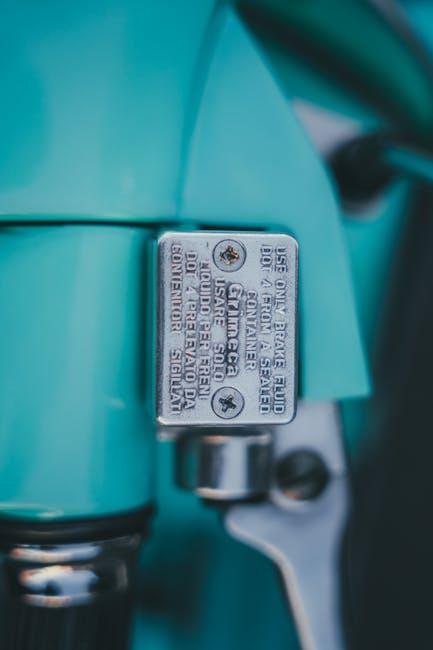In the intricate symphony of a vehicle’s dashboard, brake system warning lights often take center stage—small, glowing symbols that demand immediate attention yet remain shrouded in mystery for many drivers. These luminous alerts are more than just flickers of color; they are vital messengers, signaling the health and safety of one of your car’s most crucial systems. Understanding what these warning lights mean can transform uncertainty into confidence, turning potential panic into proactive care. In this article, we unravel the language of brake system warning lights, decoding their signals to help you navigate your journey safely and with peace of mind.
Table of Contents
- Understanding the Meaning Behind Brake System Warning Lights
- Common Causes Triggering Brake Warning Alerts
- The Importance of Immediate Action When Brake Lights Illuminate
- How to Perform Basic Brake System Checks at Home
- When to Seek Professional Brake System Diagnosis and Repair
- Preventative Tips to Avoid Brake System Malfunctions
- Q&A
- Future Outlook

Understanding the Meaning Behind Brake System Warning Lights
The brake system warning lights are designed to alert drivers to potential issues that require immediate or timely attention. These indicators often illuminate when the braking system detects a fault, such as low brake fluid levels, worn brake pads, or problems with the anti-lock braking system (ABS). Recognizing what each symbol signifies can prevent costly repairs and, more importantly, keep you safe on the road. Ignoring these warnings can lead to reduced braking performance or complete brake failure, making it crucial to address any light that appears promptly.
Not all brake warning lights are created equal, so understanding their specific meanings can help you respond appropriately. Common signals include:
- Brake Fluid Warning: Indicates low fluid levels, which can affect braking efficiency.
- ABS Warning Light: Shows a fault in the anti-lock braking system, which helps maintain control during sudden stops.
- Parking Brake Indicator: Reminds you that the parking brake is engaged or there’s a problem with its mechanism.
| Warning Light | Meaning | Recommended Action |
|---|---|---|
| Brake Fluid | Low fluid or leak detected | Check fluid level; top up or visit mechanic |
| ABS | Fault in ABS system | Have ABS inspected to ensure safety |
| Parking Brake | Engaged or faulty brake | Release brake or inspect mechanism |

Common Causes Triggering Brake Warning Alerts
Brake warning alerts often illuminate due to a variety of underlying issues, signaling the need for your immediate attention. One of the most common culprits is low brake fluid level, which usually stems from leaks within the brake lines or worn brake pads consuming fluid faster than usual. Additionally, problems like worn-out brake pads or discs can trigger sensors, alerting the system to reduced braking efficiency. It’s essential to recognize that these alerts aren’t just about stopping power—they also serve as indicators of the overall health of your braking system.
Other frequent triggers include malfunctions with the Anti-lock Braking System (ABS) sensors, often caused by dirt accumulation or damaged wiring. Faulty brake light switches and battery issues can also mistakenly activate the warning lights. For quick reference, here’s a simple overview of typical causes:
| Cause | Possible Issue |
|---|---|
| Low Brake Fluid | Leaks or worn pads |
| Worn Brake Pads | Reduced friction efficiency |
| ABS Sensor Fault | Dirty or damaged sensor |
| Brake Light Switch | Electrical malfunctions |
| Battery Problems | Low voltage supply |

The Importance of Immediate Action When Brake Lights Illuminate
As soon as your brake lights turn on, it’s a clear signal from your vehicle’s system that something demands your immediate attention. Ignoring this warning can lead to dwindling brake performance or even total system failure, compromising your safety and that of others on the road. Acting without delay not only helps prevent costly repairs but also ensures your vehicle remains roadworthy and reliable.
Here are the critical steps to take when brake lights illuminate:
- Safely pull over: Find a secure spot off the road to stop and assess the situation.
- Check brake fluid levels: Low fluid can trigger brake warnings, and topping it up might solve the issue temporarily.
- Inspect brake components: Look for signs of wear or leaks, but avoid attempting complex repairs yourself.
- Contact a professional: Schedule a diagnostic check immediately to prevent further damage.
| Warning Type | Urgency Level | Recommended Action |
|---|---|---|
| Brake System Warning Light | High | Immediate vehicle stop and professional inspection |
| ABS Light | Medium | Arrange service soon but drive cautiously |
| Brake Fluid Warning | High | Top up fluid and check for leaks immediately |

How to Perform Basic Brake System Checks at Home
Start by visually inspecting the brake pads through the wheel spokes; they should be at least 1/4 inch thick. Look for any cracks, worn surfaces, or uneven wear. You can also gently press the brake pedal to gauge resistance. A soft or spongy feeling may indicate air in the brake lines or fluid issues. Using a flashlight, check the brake fluid reservoir, ensuring the level is between the “MIN” and “MAX” marks, and the fluid remains clean and clear. Low brake fluid often triggers warning lights, so topping it up with the manufacturer-recommended fluid can sometimes illuminate the dash indicator.
Next, listen for unusual noises such as squealing or grinding when applying the brakes, which suggest worn components. Also, examine the brake rotor surfaces for scoring or discoloration, indicative of overheating or damage. Here’s a quick checklist for your brake system health:
- Brake pad thickness: Minimum ¼ inch
- Brake fluid level: Between MIN and MAX
- Brake pedal feel: Firm and consistent
- Rotor condition: Smooth, no grooves or warping
- Noise assessment: No squealing or grinding
| Check | Indication | Recommended Action |
|---|---|---|
| Pad Thickness | Below ¼ inch | Replace pads immediately |
| Brake Fluid Level | Below MIN mark | Top up fluid |
| Pedal Feel | Soft or spongy | Bleed brakes or check for leaks |
| Rotors | Grooves or warping | Resurface or replace |

When to Seek Professional Brake System Diagnosis and Repair
Recognizing the moment when your brake warning light signals a serious issue is crucial for your safety and vehicle longevity. If the warning light flashes continuously, or if it remains illuminated after restarting your car, these are definite signs to consult a professional. Other indicators that mechanical intervention is needed include unusual brake noises, a soft or spongy feeling in the brake pedal, and the vehicle pulling to one side during braking. Such symptoms often point to deeper issues like brake fluid leaks, worn brake pads, or sensor malfunctions, all of which demand expert diagnostics beyond a simple inspection.
To help you understand when to act swiftly, here’s a quick reference table outlining common brake warning light behaviors and suggested actions:
| Warning Light Behavior | Possible Cause | Action Required |
|---|---|---|
| Steady Light | Low brake fluid, worn pads | Schedule service promptly |
| Flashing Light | ABS malfunction | Immediate professional diagnosis |
| Light On + Brake Noise | Brake wear or damage | Stop driving and get inspected |
- Do not ignore persistent brake warnings.
- Avoid delaying repairs as it risks your safety.
- Trust certified technicians for accurate fault detection.

Preventative Tips to Avoid Brake System Malfunctions
Keeping your brake system in optimal condition requires consistent attention and simple habits. Start by regularly checking your brake fluid levels; low fluid can trigger warning lights and reduce braking efficiency. Equally important is inspecting brake pads for wear — worn pads cause uneven braking and can damage rotors, leading to costly repairs. Make it a habit to listen for unusual noises like squeaks or grinding sounds, which are early indicators of brake issues. Ensuring tire pressure is within recommended ranges also supports balanced braking and helps your car maintain proper traction on the road.
Additionally, seasonal maintenance can prevent unexpected failures, especially before harsh weather conditions. Here’s a quick checklist to help you stay ahead:
- Brake fluid replacement: Every 2 years or as recommended.
- Visual inspection: Monthly check for leaks or damage.
- Professional brake system scan: Annually or when warning lights appear.
- Brake pad thickness: Replace if under 3mm.
| Maintenance Task | Recommended Frequency | Key Benefit |
|---|---|---|
| Brake Fluid Check | Every 6 months | Prevents system corrosion |
| Brake Pad Inspection | Monthly | Ensures safe stopping power |
| Brake System Flush | Every 2 years | Removes moisture build-up |
Q&A
Q&A: Brake System Warning Lights Explained
Q1: What exactly are brake system warning lights?
A: Brake system warning lights are alert signals on your vehicle’s dashboard that indicate the status of your braking system. They serve as your car’s way of saying, “Hey, something might be wrong here—pay attention!” These lights ensure you stay informed about potential brake issues before they become serious safety hazards.
Q2: What are the most common brake warning lights I should watch out for?
A: The usual suspects include the brake warning light (often a red exclamation mark inside a circle or the word “BRAKE”), the ABS (Anti-lock Braking System) light, and sometimes the brake fluid warning light. Each has its own story but generally relates to your vehicle’s ability to stop safely.
Q3: What does it mean when the brake warning light comes on?
A: When the brake warning light illuminates, it could signal several things: your parking brake might still be engaged, brake fluid might be low, or there might be an issue with the brake pads or hydraulic system. It’s a prompt to check the parking brake first, then consult your mechanic if the light stays on.
Q4: Is it safe to keep driving if the brake warning light is on?
A: It’s best to avoid long drives when this light warns you. Brake issues can escalate quickly, risking your safety. Pull over safely, test your brakes gently, and if anything feels unusual, have the vehicle inspected immediately.
Q5: How does the ABS warning light differ from the general brake warning light?
A: The ABS light specifically relates to your vehicle’s Anti-lock Braking System. If this light stays on, it means the ABS might be malfunctioning, which can affect how your brakes respond in slippery conditions. While your standard brakes may still work, the ABS feature won’t help avoid skidding or loss of control.
Q6: What should I do if both the brake and ABS lights come on simultaneously?
A: Dual warnings often suggest a more serious issue within the brake system, possibly affecting general braking function and ABS. It’s critical to stop driving as soon as it’s safe and have your vehicle inspected without delay.
Q7: Can low brake fluid trigger these warning lights?
A: Absolutely. Brake fluid is essential for hydraulic pressure in your braking system. Low fluid levels can illuminate the brake warning light, indicating leaks, worn brake pads, or the need for maintenance.
Q8: Are there any simple checks I can perform at home when these lights appear?
A: Yes! First, ensure your parking brake is fully released. Next, check the brake fluid reservoir (usually under your hood) and top it up if it’s below the minimum mark. However, if lights persist, professional diagnostics are recommended.
Q9: How often should the brake system be inspected to avoid warning lights?
A: Regular brake inspections—typically every 10,000 to 15,000 miles or according to your vehicle’s manual—help prevent unexpected warnings. Early detection of wear or fluid issues keeps your stopping power reliable.
Q10: Why is it important not to ignore brake system warning lights?
A: Your brakes are your lifeline on the road. Ignoring warning lights can lead to brake failure, longer stopping distances, and increased chances of accidents. Heeding these signals ensures your safety and peace of mind behind the wheel.
Future Outlook
Understanding the language of your vehicle’s brake system warning lights is more than just a mechanic’s handbook—it’s a lifeline on the road. These small, glowing icons serve as early messengers, alerting you to potential issues before they become serious dangers. By recognizing what each symbol means and responding promptly, you keep not only your car in top shape but also yourself and others safe. So next time that brake light flickers on your dashboard, let it be a clear signal to pause, assess, and act—because every journey deserves a confident, controlled stop.
